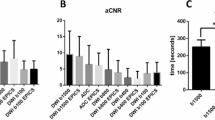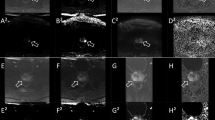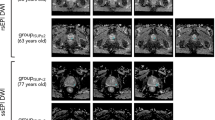Abstract
Background:
To evaluate whether very high b-value computed diffusion-weighted imaging (cDWI) is able to provide better contrast between the foci of prostate cancer and background tissue than the standard apparent diffusion coefficient (ADC) map, and whether this improved contrast could be used to improve the tumor detection.
Methods:
Very high b-value cDWI series up to b4000 were created for 14 patients with high-grade prostate cancer. Contrast-to-noise ratios (CNRs) and CNR-to-ADC ratios were calculated. Three blinded readers also assessed the tumor conspicuity on a standard five-point scale.
Results:
The tumor CNR increased with increasing b-values in all the patients up to a maximum average CNR of 75.1 for a b-value of 4000 (average CNR for the ADC maps: 10.0). CNR/ADC ratios were higher than 1 (indicating higher CNR than respective ADC) for cDWI of 1500 and higher, with a maximum of 6.5 for cDWI4000. The average subjective tumor conspicuity scores for cDWI2000, 3000 and 4000 were significantly higher than that of the ADC (4.0): 4.5 (P=0.018), 4.5 (P=0.017) and 4.6 (P=0.012).
Conclusions:
cDWI is able to provide better contrast between the foci of prostate cancer and background tissue compared with a standard ADC map. This resulted in improved subjective tumor conspicuity.
This is a preview of subscription content, access via your institution
Access options
Subscribe to this journal
Receive 4 print issues and online access
$259.00 per year
only $64.75 per issue
Buy this article
- Purchase on SpringerLink
- Instant access to full article PDF
Prices may be subject to local taxes which are calculated during checkout





Similar content being viewed by others
References
Gupta RT, Kauffman CR, Polascik TJ, Taneja SS, Rosenkrantz AB . The state of prostate MRI in 2013. Oncology (Williston Park) 2013; 27: 262–270.
Tan CH, Wei W, Johnson V, Kundra V . Diffusion-weighted MRI in the detection of prostate cancer: meta-analysis. AJR Am J Roentgenol 2012; 199: 822–829.
McNeal JE, Redwine EA, Freiha FS, Stamey TA . Zonal distribution of prostatic adenocarcinoma. Correlation with histologic pattern and direction of spread. Am J Surg Pathol 1988; 12: 897–906.
Koh DM, Collins DJ . Diffusion-weighted MRI in the body: applications and challenges in oncology. AJR Am J Roentgenol 2007; 188: 1622–1635.
Le Bihan D, Poupon C, Amadon A, Lethimonnier F . Artifacts and pitfalls in diffusion MRI. J Magn Reson Imaging 2006; 24: 478–488.
Blackledge MD, Leach MO, Collins DJ, Koh DM . Computed diffusion-weighted MR imaging may improve tumor detection. Radiology 2011; 261: 573–581.
Rosset A, Spadola L, Ratib O . OsiriX: an open-source software for navigating in multidimensional DICOM images. J Digit Imaging 2004; 17: 205–216.
Dickinson L, Ahmed HU, Allen C, Barentsz JO, Carey B, Futterer JJ et al. Magnetic resonance imaging for the detection, localisation, and characterisation of prostate cancer: recommendations from a European consensus meeting. Eur Urol 2011; 59: 477–494.
Turkbey B, Mani H, Shah V, Rastinehad AR, Bernardo M, Pohida T et al. Multiparametric 3 T prostate magnetic resonance imaging to detect cancer: histopathological correlation using prostatectomy specimens processed in customized magnetic resonance imaging based molds. J Urol 2011; 186: 1818–1824.
Riches SF, Payne GS, Morgan VA, Sandhu S, Fisher C, Germuska M et al. MRI in the detection of prostate cancer: combined apparent diffusion coefficient, metabolite ratio, and vascular parameters. AJR Am J Roentgenol 2009; 193: 1583–1591.
Maas MC, Futterer JJ, Scheenen TW . Quantitative evaluation of computed high b value diffusion-weighted magnetic resonance imaging of the prostate. Invest Radiol 2013; 48: 779–786.
Bomers JG, Barentsz JO . Standardization of multiparametric prostate MR imaging using PI-RADS. Biomed Res Int 2014; 2014: 431680.
Rosenkrantz AB, Chandarana H, Hindman N, Deng FM, Babb JS, Taneja SS et al. Computed diffusion-weighted imaging of the prostate at 3 T: impact on image quality and tumour detection. Eur Radiol 2013; 23: 3170–3177.
Author information
Authors and Affiliations
Corresponding author
Ethics declarations
Competing interests
The authors declare no conflict of interest.
Rights and permissions
About this article
Cite this article
Feuerlein, S., Davenport, M., Krishnaraj, A. et al. Computed high b-value diffusion-weighted imaging improves lesion contrast and conspicuity in prostate cancer. Prostate Cancer Prostatic Dis 18, 155–160 (2015). https://doi.org/10.1038/pcan.2015.5
Received:
Revised:
Accepted:
Published:
Issue date:
DOI: https://doi.org/10.1038/pcan.2015.5
This article is cited by
-
Automated deep-learning system in the assessment of MRI-visible prostate cancer: comparison of advanced zoomed diffusion-weighted imaging and conventional technique
Cancer Imaging (2023)
-
Post-MRI transrectal micro-ultrasonography of transition zone PI-RADS > 2 lesions for biopsy guidance
European Radiology (2022)
-
Stimulated-echo diffusion-weighted imaging with moderate b values for the detection of prostate cancer
European Radiology (2020)
-
MRI for prostate cancer: can computed high b-value DWI replace native acquisitions?
European Radiology (2019)
-
Diffusion-weighted imaging of the prostate: should we use quantitative metrics to better characterize focal lesions originating in the peripheral zone?
European Radiology (2018)



